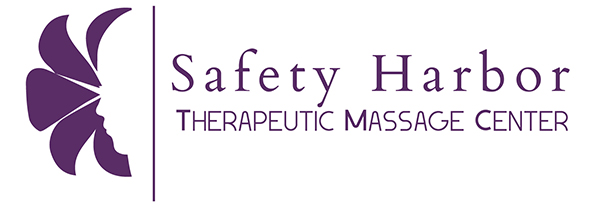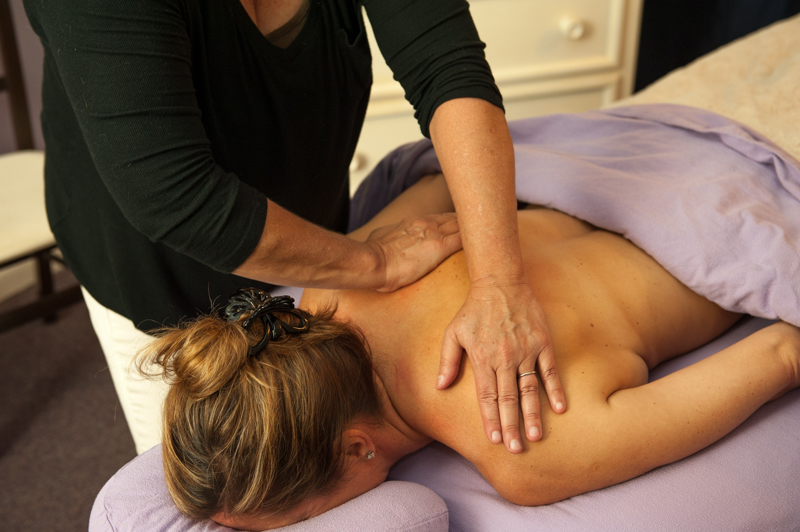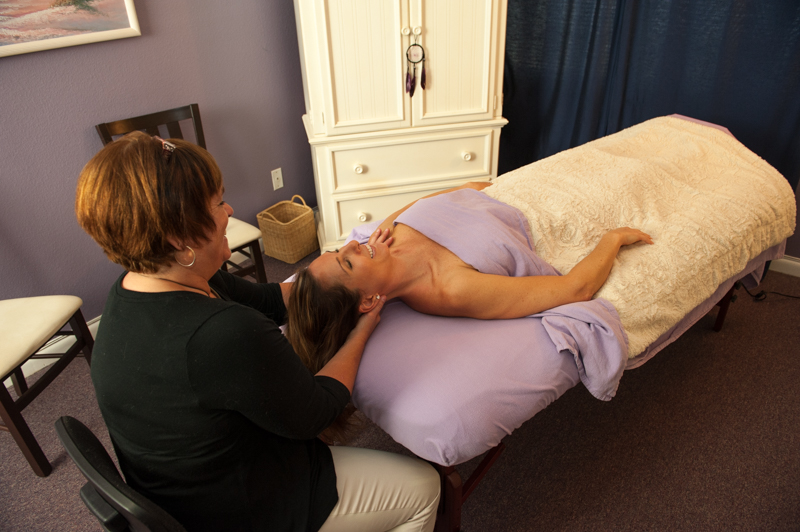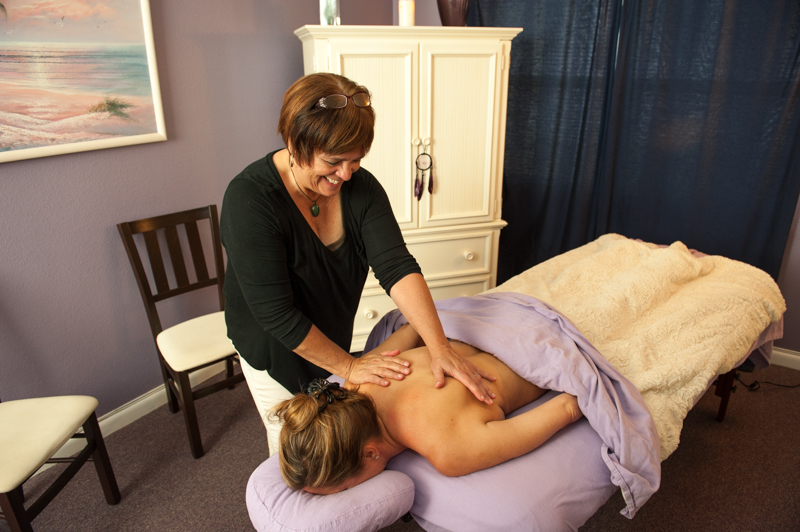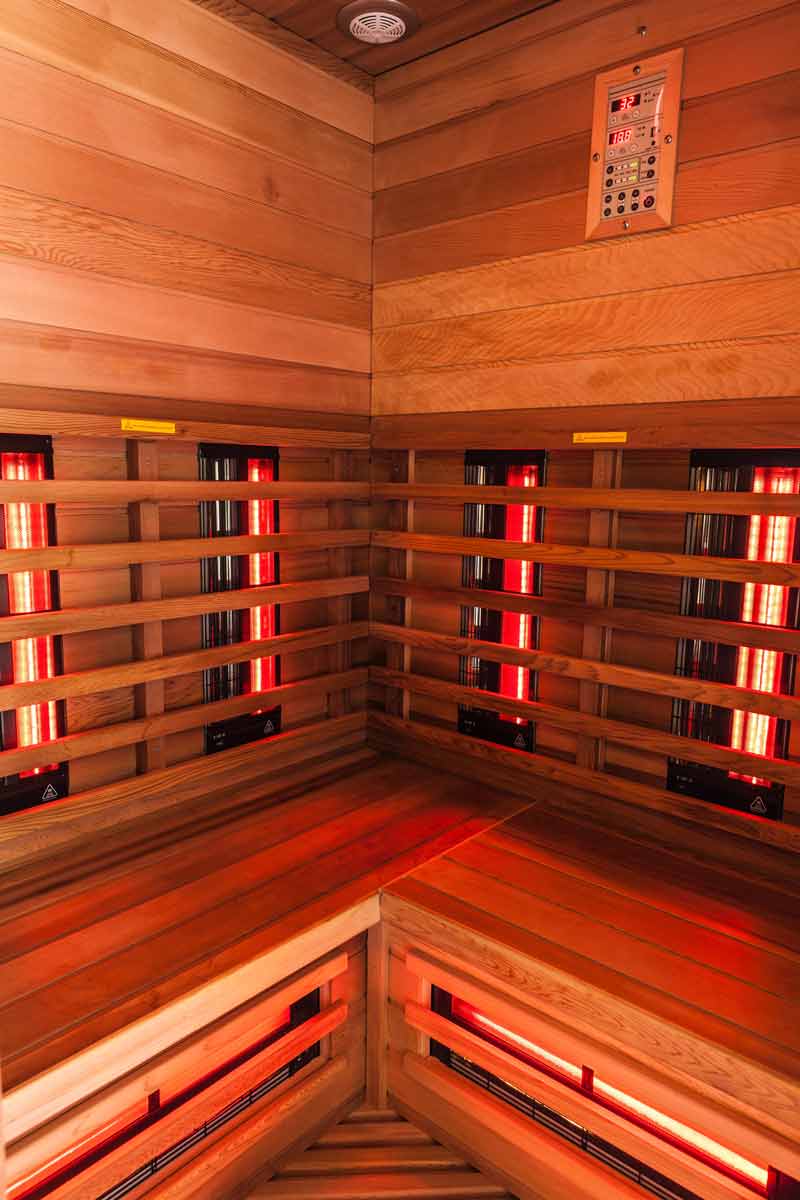Your Most Vital Possession is your Health
The Benefits
the Benefits
Massage Therapy
Experts estimate that upwards of ninety percent of disease is stress-related. And perhaps nothing ages us faster, internally and externally, than high stress. A massage is an effective tool for managing this stress, which translates into:
- Decreased anxiety
- Enhanced sleep quality
- Greater energy
- Improved concentration
- Increased circulation
- Reduced fatigue
Massage can also specifically help address
a number of health concerns.
Bodywork can:
- Alleviate low-back pain and improve range of motion.
- Assist with shorter, easier labor for expectant mothers and shorten maternity hospital stays.
- Ease medication dependence.
- Enhance immunity by stimulating lymph flow—the body’s natural defense system.
- Exercise and stretch weak, tight, or atrophied muscles.
- Help athletes of any level prepare for, and recover from, strenuous workouts.
- Improve the condition of the body’s largest organ—the skin.
- Increase joint flexibility.
- Lessen depression and anxiety.
- Promote tissue regeneration, reducing scar tissue and stretch marks.
- Pump oxygen and nutrients into tissues and vital organs, improving circulation.
- Reduce postsurgery adhesions and swelling.
- Reduce spasms and cramping.
- Relax and soften injured, tired, and overused muscles.
- Release endorphins—amino acids that work as the body’s natural painkiller.
- Relieve migraine pain.
Therapeutic Technique Terminology
Learn More About…
Dermaplaning
Dermaplaning is a skin treatment that uses an exfoliating blade to skim dead skin cells and hair from your face in an effort to improve the skin’s surface and create a smooth and more youthful appearance. It is also referred to as microplaning or blading.
Energy Massage
Energy Massage: Incorporates influential breathing techniques throughout a medium pressure massage.
Instrument Assisted Soft Tissue Mobilization (IASTM)
Instrument Assisted Soft Tissue Mobilization (IASTM) is a safe and effective therapeutic technique. It utilizes metal or plastic tools to facilitate myofascial release to improve soft tissue mobility in your body. These ergonomically shaped tools help your massage therapist to mobilize your muscles, fascia (the collagen covering your muscles), and tendons. This is thought to reduce pain and improve movement.
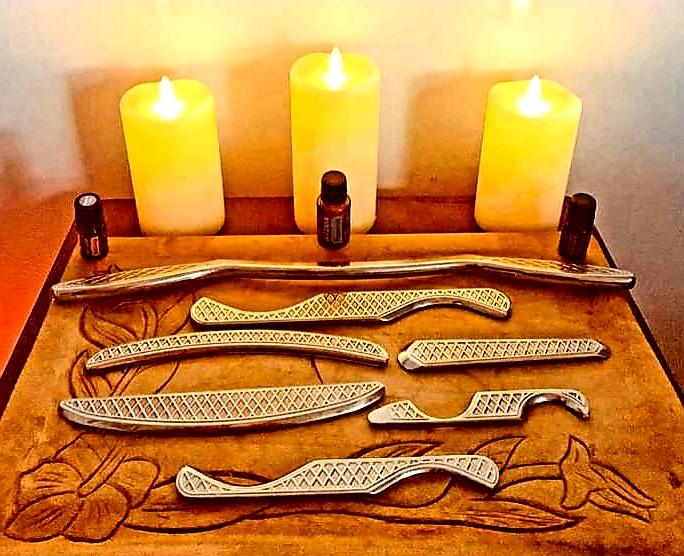
Medicupping
Medicupping: A treatment technique that utilizes glass cups that are attached to suction to help release & restore fused tissue layers. It can be used for problems in the lymphatic system, scar tissue restrictions, general inflammation, and relieving chronic pain conditions. See our page on MediCupping “What to Expect”
Microdermabrasion
Microdermabrasion is a minimally invasive procedure used to renew overall skin tone and texture. It can improve the appearance of sun damage, wrinkles, fine lines, age spots, acne scarring, melasma, and other skin-related concerns and conditions.
The process utilizes a special applicator that sprays aluminum oxide or sodium bicarbonate with a vacuum/suction that gently and deeply exfoliates the skin layers. It is indicated for the following conditions as well as those who are seeking healthier, vibrant, and rejuvenated skin.
- fine lines and wrinkles
- hyperpigmentation, age spots and brown spots
- enlarged pores and blackheads
- acne and acne scars
- stretch marks
- dull-looking skin complexion
- uneven skin tone and texture
- melasma
- sun damage
Muscle Flushing
Muscle Flushing: Enhances the recovery process for athletes, sports competitors, and high-performance individuals.
Myofascial Release (MFR)
Myofascial Release (MFR): a technique that involves applying gentle sustained pressure into the Myofascial connective tissue restrictions which eliminate pain and can restore motion to the muscles and joints. It can improve blood flow, oxygenate the muscles, improve lymphatic circulation, and stimulates the stretch reflex in muscles.
Neuromuscular Therapy (NMT) – Trigger Point
This approach to massage therapy combines soft tissue manipulation techniques of various fields in the healing arts including trigger point therapy. You can also expect flexibility stretching to support balancing the musculoskeletal and nervous systems, and diminish the causes of neuromuscular pain. The therapist often uses fingers, knuckles, or elbows to apply alternating levels of pressure, which increases circulation and helps to relax the painful muscles. This area of massage therapy improves muscle and joint function.
Percussion Massage (Also known as a Therapeutic Massage Gun)
Percussion Massage: Incorporates a handheld massage gun during a therapeutic, deep tissue treatment to stimulate pain relief.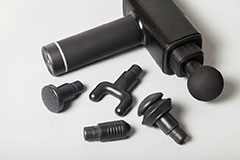
Prenatal/Postnatal (Pregnancy) Massage
Prenatal/Postnatal (Pregnancy) Massage: Starting with the second trimester all the way to the end of the third trimester, this massage technique is sensitive to the needs of a woman’s body, and uses specialized tools to support the body while relieving muscle tension, aches and joint pain, and often can improve labor outcomes and newborn health.
Structural Integration
Structural Integration: helps the body get out of a pain response. It
is a pain-free system to address joint pain, ligament pain, nerve
pain, muscle-tendon strain pain, scar tissue pain, and muscle/joint
imbalance pain through manual manipulation of the body for a
pain-free living experience. It utilizes a muscle activator for weak
and neurologically inhibited muscles. Using good assessment and
identifying your specific compensation patterns is as effective aswell as relaxing massage.
Swedish/Relaxation Massage
Swedish/Relaxation Massage: the most common type of massage therapy utilizes circular pressure, firm kneading, light tapping, and easy strokes.
Therapeutic Deep Tissue/ Sports Massage
Therapeutic Deep Tissue/ Sports Massage: a technique that’s mainly used to treat musculoskeletal issues, such as strains and sports injuries and involves applying sustained pressure using slow, deep strokes to target the inner layers of your muscles and connective tissues. This process helps to break up scar tissue, increase blood flow, improve healing, and reduce inflammation in the muscle tissue of an injury.
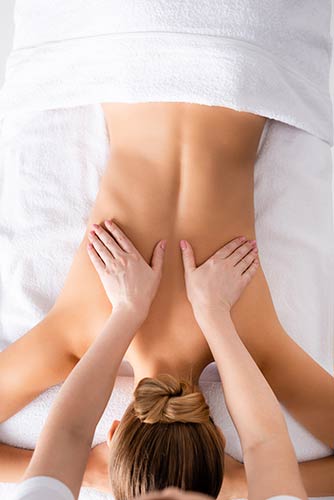
Self Care Practice
Nurture Yourself
the Benefits
Infrared Sauna Therapy
Support Detoxification
Infrared waves penetrate deep into the body, helping to eliminate a wide range of toxins, including heavy metals, environmental pollutants, and drug residues. The deep sweat helps support your body’s natural detox systems and lymphatic drainage.
Boost Metabolism & Aid Weight Loss
Increasing your core body temperature during an infrared sauna session is similar to the effect of cardiovascular exercise. This process stimulates a sluggish metabolism and helps your body eliminate toxins that can contribute to fat storage, making it an excellent addition to any weight management program.
Improve Heart Health
Clinically proven to temporarily reduce both systolic and diastolic blood pressure, regular use of our infrared sauna can be a great way to support your cardiovascular system.
Repair Muscles Faster
Infrared heat penetrates joints and muscles, which can help relieve soreness, improve flexibility, and speed up tissue regeneration. This makes it a popular recovery tool for athletes and anyone looking to soothe their body after physical activity.
Enhance Relaxation and Relieve Stress
Step into the sauna to sweat out stress and find your calm. The gentle heat helps balance cortisol levels, relax muscles, and relieve tension throughout your body, leading to a profound sense of peace and well-being.
Rejuvenate Skin
As the infrared heat induces a deep sweat, it helps open your pores, leading to a clearer and more refreshed complexion. Regular sessions can improve the overall appearance and health of your skin.
Improve Sleep Quality
Using the sauna as part of your evening routine can help promote relaxation and create a healthy circadian rhythm, helping you achieve a deeper, more restorative night’s sleep.
Strengthen Immunity
The temporary increase in core body temperature, similar to a fever, activates and strengthens your immune system, helping to stimulate heat shock proteins that can deter illness.
Frequently asked questions
FAQs
Contraindications - Post Surgery/Wounds
You should not use an infrared sauna immediately after surgery to avoid infection and complications, especially with open wounds or sutures. Wait until your incisions are fully closed, your stitches are removed, and your doctor gives you specific permission, as increased blood flow and heat can be harmful to healing tissue. Once cleared, the increased circulation might help, but your primary focus must be on safe, doctor-approved healing.
Immediate post-operative period
- Do not use a sauna with open wounds: Wounds must be kept dry and protected from bacteria, hot tubs, and saunas until they are fully healed and sutures are removed.
- Follow your surgeon’s instructions: Your doctor will provide specific guidelines on wound care and when it is safe to expose your body to heat and increased circulation.
Long-term healing
- Wait for clearance: Do not use a sauna of any kind after surgery until you have been explicitly cleared by your doctor, which can take several weeks or longer depending on the procedure.
- Understand potential risks: For procedures like breast implants, waiting six weeks is often recommended to allow for adequate healing.
- Infrared heat may help later: Once your doctor approves, the increased blood flow from infrared heat could potentially help deliver oxygen to damaged tissues, aiding in recovery. However, this is a secondary benefit to following medical advice.
Are there any contraindications for sauna use?
If any of the below apply to you, consult your physician prior to sauna use.
• Post Surgery/Wounds – Individuals recovering from recent surgery, stitches, or any open wounds.
• Cardiovascular Issues, Obesity or Diabetes – Individuals suffering from obesity or with a medical history of heart disease, low or high blood pressure, circulatory problems, or diabetes should consult a physician prior to use. Heat stress increases cardiac output and blood flow in an effort to transfer internal body heat to the outside environment via the skin (perspiration) and respiratory system. This takes place primarily due to major changes in the heart rate, which has the potential to increase by thirty (30) beats per minute for each degree increase in core body temperature.
• Medications – Individuals who are using prescription drugs should seek the advice of their personal physician since some medications may induce drowsiness, while others may affect heart rate, blood pressure and circulation. Diuretics, barbiturates, and beta-blockers may impair the body’s natural heat loss mechanisms. Anticholinergics, such as amitriptyline, may inhibit sweating and can predispose individuals to heat rash or to a lesser extent, heat stroke. Some over-the-counter drugs, such as antihistamines, may also cause the body to be more prone to heat stroke.
• Alcohol & Drug Abuse – Contrary to popular belief, it is not advisable to attempt to “sweat out” a hangover. Alcohol intoxication decreases a person’s judgment; therefore, he/she may not realize when the body has a negative reaction to high heat. Alcohol also increases the heart rate, which may be further increased by heat stress. The use of alcohol, drugs, or medications prior to a sauna session may lead to unconsciousness.
• Elderly – The ability to maintain core body temperature decreases with age. This is primarily due to circulatory conditions and decreased sweat gland function. The body must be able to activate its natural cooling processes in order to maintain core body temperature. If elderly, operate at a lower temperature and for no more than 15 minutes at a time.
• Children – The core body temperature of children rises much faster than adults. This occurs due to a higher metabolic rate per body mass, limited circulatory adaptation to increased cardiac demands, and the inability to regulate body temperature by sweating. When using with a child, operate at a lower temperature and for no more than 15 minutes at a time.
• Chronic Conditions / Diseases Associated with Reduced Ability to Sweat or Perspire – Multiple Sclerosis, Central Nervous System Tumors, and Diabetes with Neuropathy are conditions that are associated with impaired sweating. Consult a physician.
• Hemophiliacs / Individuals Prone to Bleeding – The use of infrared saunas should be avoided by anyone who is predisposed to bleeding.
• Fever & Insensitivity to Heat – Individuals with insensitivity to heat or who have a fever should not use the sauna until the fever subsides.
• Pregnancy – Pregnant women should consult a physician before using an infrared sauna.
• Menstruation – Heating of the low back area of women during the menstrual period may temporarily increase menstrual flow. This should not preclude sauna use.
• Joint Injury – Recent (acute) joint injury should not be heated for the first 48 hours or until the swollen symptoms subside. Joints that are chronically hot and swollen may respond poorly to vigorous heating of any kind.
• Implants – Metal pins, rods, artificial joints, or any other surgical implants generally reflect infra-red waves and thus are not heated by this system. Nevertheless, you should consult your physician prior to using.
• Pacemakers / Defibrillators – The magnets used to assemble our saunas can interrupt the pacing and inhibit the output of pacemakers. Please discuss with your doctor the possible risks this may cause. In the rare event that you experience pain or discomfort, immediately discontinue sauna use.
What do I wear?
To enable infrared to penetrate tissues as deep as possible, we recommend wearing as little as
possible. A bamboo carbon body wrap, cotton towel, gym shorts or swimsuit are perfect options. Most
businesses require clients to wear clothing or a towel to keep the sauna clean. We offer bath towels
and body wraps infused with CELLIANT that reflect the body’s infrared back into the body, enhancing
and extending the benefits of infrared before, during, and after their session.
How often should I use the sauna?
One session will leave you feeling refreshed and rejuvenated. But similar to exercise, the more you do
it, the better the results. Recommended use is 3-4 times per week for 30-40 minutes.
When will I start sweating?
Sweat levels are different for everyone. Don’t be surprised if you don’t sweat during the first few
sessions. Sweating will increase with regular use. Even if your body is not drenched in sweat, your body is still detoxifying from harmful toxins. Also, be sure to drink plenty of water before your session. If you are dehydrated, you will not sweat as much. If you are hydrated properly and want a sweat boost, try our Pure Sweat amplifying cream. Pure Sweat can triple your sweat and increase circulation.
Do I need a doctor’s note?
No. If you have health concerns, we recommend speaking with your doctor before your sauna session.
Is the Infrared coming from lights?
No. Infrared heaters are located on the floor, front, back, and side wall panels. The chromotherapy
lights are not infrared.
Are there any studies on infrared therapy?
There are various studies on the use of infrared for a multitude of health benefits. Specifically, Sunlighten
infrared saunas have been shown to increase core temperature for detoxification, temporarily lower
blood pressure, and increase flexibility. Many other studies have shown infrared saunas to increase skin
health, aid in relaxation and mental health, and support reduction of waist circumference. These studies can be found on Sunlighten’s website via the Light Science research library.
Are children allowed to use the sauna?
The core body temperature of children rises much faster than adults. When taking a sauna session with
a child, operate at a lower temperature and for no more than 15 minutes at a time. A general rule of
thumb is one minute inside your sauna per year of age for the child, but always accompanied by an
adult. And remember to keep you and your children hydrated, even if you don’t see them sweating.
Is it ok to use the sauna while breastfeeding?
Can I take my cell phone into the sauna?
Can I sauna while pregnant?
Relax
Rebalance
Rejuvenate
Retreat
Sharing Answers to Our Most
Frequently Asked Questions
Where will my massage or bodywork session take place?
Your massage or bodywork session will take place in a warm, comfortable, quiet room. Soft music may be played to help you relax. You will lie on a table especially designed for your comfort.
Must I be completely undressed?
Most massage and bodywork techniques are traditionally performed with the client unclothed; however, it is entirely up to you what you want to wear. You should undress to your level of comfort. You will be properly draped during the entire session.
Will the practitioner be present when I disrobe?
The practitioner will leave the room while you undress, relax onto the table, and cover yourself with a clean sheet or towel.
Will I be covered during the session?
You will be properly draped at all times to keep you warm and comfortable. Only the area being worked on will be exposed.
What parts of my body will be massaged?
A typical full-body session will include work on your back, arms, legs, feet, hands, head, neck, and shoulders.
What will the massage or bodywork feel like?
A relaxing Swedish massage is often a baseline for clients. In a general Swedish massage, your session may start with broad, flowing strokes that will help calm your nervous system and relax exterior muscle tension. As your body becomes relaxed, pressure will gradually be increased to relax specific areas and relieve areas of muscular tension. A deep tissue massage will have deeper pressure, but should not be painful. Always communicate with your therapist. Lotion or massage cream is used to allow your muscles to be massaged without causing excessive friction to the skin. This also helps hydrate your skin. You should communicate immediately if you feel any discomfort so that another approach may be taken. Massage and bodywork are most effective when your body is not resisting. Your therapist wants your session to be exactly what you would like, so don’t be afraid to speak up if the pressure is not what you would like or if something is uncomfortable.
Are there different kinds of massage and bodywork?
There are numerous types of massage and bodywork; various techniques utilize different strokes, posture and movement re-education, application of pressure to specific points, and more. We can discuss which methods may be most appropriate for you and tailor your massage session for what you need specifically on that particular day. Every session is different depending on the needs of each client, so always share your goal for the session with your therapist.
What should I do during the massage or bodywork session?
Prior to the massage, feel free to ask the practitioner any questions about the technique or the upcoming session. During the massage, make yourself comfortable. The practitioner will either gently move you or tell you what is needed throughout the session (such as lifting your arm). Many people just close their eyes and completely relax, communicating if/when they need more or less pressure, another blanket, or anything else relevant to the session. If you have any questions regarding the session or about the particular technique you are receiving, feel free to ask.
How will I feel after the massage or bodywork session?
Most people feel very relaxed. Some experience freedom from long-term aches and pains developed from tension or repetitive activity. After an initial period of feeling slowed down, people often experience increased energy, heightened awareness, and greater productivity which can last for days. Since toxins are released from your soft tissues during a massage, it is recommended you drink plenty of water following your massage.
What are the benefits of massage and bodywork?
Massage and bodywork can help release chronic muscular tension and pain, improve circulation, increase joint flexibility, reduce mental and physical fatigue and stress, promote faster healing of injured muscular tissue, improve posture, and reduce blood pressure. Massage and bodywork is also known to promote better sleep, improve concentration, reduce anxiety and create an overall sense of well-being.
Are there any medical conditions that would make massage or bodywork inadvisable?
Yes. That’s why it’s imperative that, before you begin your session, the practitioner asks general health questions. It is very important that you inform the practitioner of any health problems or medications you are taking. If you are under a doctor’s care, it is strongly advised that you receive a written recommendation for massage or bodywork prior to any session. Depending on the condition, approval from your doctor may be required.
What Precautions are you taking with regards to health and exposure?
We have always taken great care to maintain a clean and healthy facility. Your health has always been our 1st priority. We keep an updated list of our safety and sanitation practices during this unprecedented time on our COVID page, so that you are always informed. You can also click the link in the navigation for more.
Extend Your Self Care
Massage Packages
Save $15 off 3 services. Mix and match services however you like. Your package credit stays on file, never expires, and you can share them with friends and family. (*No package pricing on 30-minute sessions)
RELAXATION
Three - 60-Minute Sessions ($195)
Savings = $65 for each session
Three - 90 Minute Sessions ($315)
Savings = $105 for each session
COMBINATION
Three - 60-Minute Sessions ($225)
Savings = $75 for each session
Three - 90 Minute Sessions ($345)
Savings = $115 for each session
SPECIALTY/DEEP TISSUE/SPORTS
Three - 60-Minute Sessions ($255)
Savings = $85 for each session
Three - 90 Minute Sessions ($390)
Savings = $130 for each session
